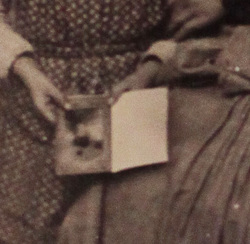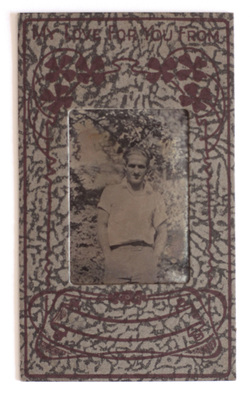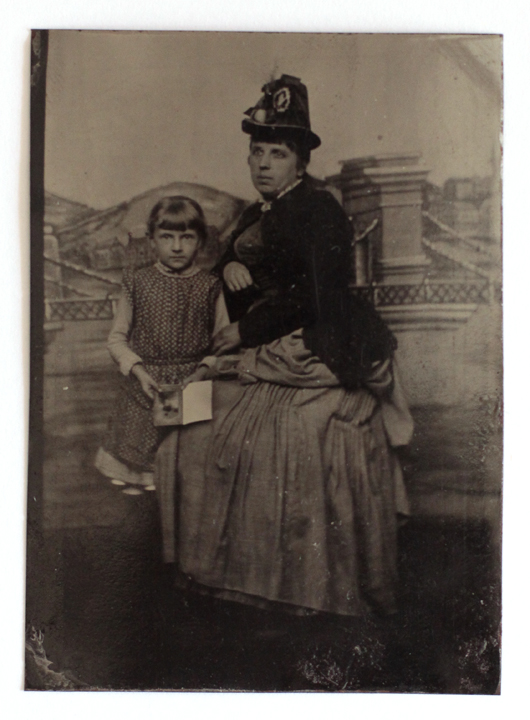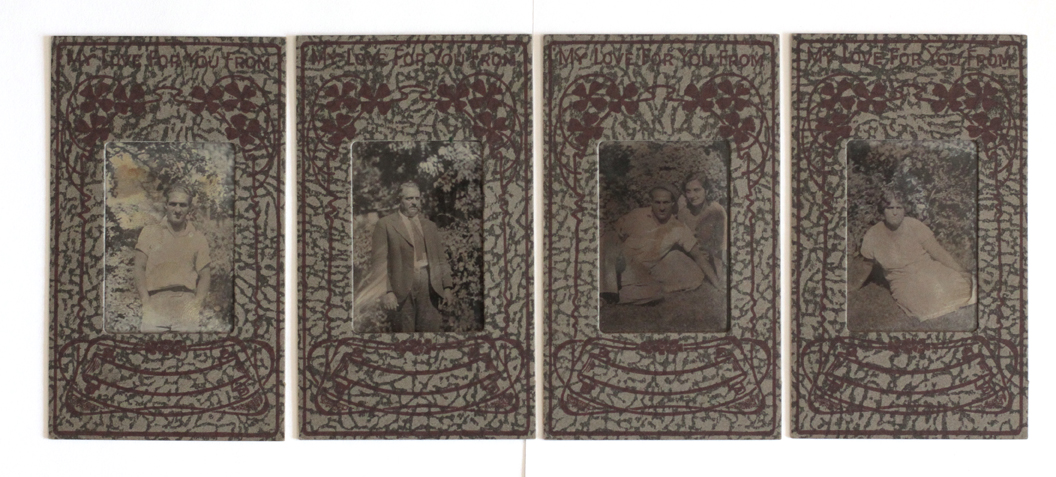 This is one of my favorite photo pieces. After you examine enough historical photos and a little more research, you begin to recognize certain motifs that seem to pop up again and again. Often studio portraits involve someone holding a book or a hat as a prop. Others have a curious addition of another photograph. Sometimes they are sitting on a table. Sometimes they are held. Sometimes they sit on an empty chair. I find these objects fascinating for many reasons, but one being the re-duplication of an image...an early form of re-photography. But why did this motif emerge? In some it seems like the photographed subject is merely contemplating the image, but others have a much emotive tale. Frequently the photograph is used as a substitute or surrogate reminder of someone who is no longer living. Were we able to zoom in more to the photo in this child's hands we may well find it to be an image of a sibling or more likely her father who is now deceased. These photos fall into an fascinating niche of photo history often called "mourning photography".
0 Comments
 A few weeks ago I picked up these cheap little tintypes. They were advertised as carnival tintypes. Which seems to make sense since they are qualitatively different than typical tintypes with a very silvery surface and seem much cheaper in look. The card into which they are placed looks similar to the older tintype, but these look much more the part of a 20th C. product based on the script and design of the card and of course the clothing of those pictured. I thought the set of four were unique enough to pick up the lot as I have seen only one image like this before in the same card which reads "My love for you from...) I grew up going to flea markets and antique shops with my mother. She went for the antiques. I went with hopes of finding baseball cards. Later I found an interest in old print ads and magazines, and antiques in general. As of late, I have actually started hitting up antique shops again for a new kind of collection. My MFA work at the University of North Dakota used old vernacular photographs culled into an archive to explore how we think about objects. But since then I have taken to a deeper interest in vernacular photos, their kinds, histories, and oddities.
Last fall I took a historical research methods course, where I formulated a project centering on mourning imagery of the Victorian age. Would could become an ambitious MA thesis project has spurred me on toward thinking about teaching a history of photography and utilizing vernacular photographs as teaching aids. Geoffery Batchen, and others, have argued that photo history (like most history) has focussed on great men and great events. But Social history has turned the focus toward the perimeter and explored the common human experience. Within photo history, vernacular photo is typically excluded from the narratives that focus upon the greats of the tradition. Yet, the most common forms of photo that humanity is most familiar with, are often left out. As an educator, my hope is to include these vernacular works into the history of photography. My recent trips to antique shops, and time surfing Ebay, I have been looking for a variety of old photographic objects that will be used as teaching aids for a future history of photo class that I hope to teach. So over the next while, I will be posting some of my own collection and other photos from my growing collection that I just love. This study was a profound experience for me. So much more could and should be said about each Psalm that carries one of the accusatory questions. What started off as a musing on the aggressive prayers that Israel seemed to offer has become a provocative challenge to both covenant and Creator. This study has also cemented in my mind the need for lament in ecclesial communities. Without it, our liturgies lack a certain honesty about our selves and our world. We need to overcome the isolating tendencies of individualism on both the personal and ecclesial scale and rediscover our solidarity with a crumbling and disoriented world. Rediscovering our social reality is fundamental to rediscovering lament. When we do, we will find the need for such language again. Such a language will “help the church genuinely mourn the world’s enmity and pain, give a voice to the voiceless, and witness against injustice.”[1] Lament offers the church a solid “rhetoric for prayer and reflection that befits these volatile times, a rhetoric that mourns loss, examines complicity in evil, cries for divine help, and sings and prays with hope. For indeed, what ultimately shapes lament is not the need of the creature to cry its woe, but the faithfulness of the God, who hears and acts.”[2] [1] Sally Brown & Patrick Miller, ed., “Introduction,” in Lament: Reclaiming Practices in Pulpit, Pew, and Public Square, (Louisville: Westminster John Knox Press, 2005), xix. [2] Ibid. Before Christmas I started re-posting this series of reflection on the Lament and complaint Psalms. Psalm 79 is another striking example for the communal complaint and lament that closely resembles Psalm 74. It is a very human plea to Yahweh to act on behalf of a sinful Israel who has been overrun by her enemies. Tate notes that the destruction of Israel is not just a theological crisis, but also a political, social, and economic results.[1] Not one aspect of their life was left untouched. The first five verses describe the horrific scene to Yahweh. All three participants, Yahweh, psalmist/community, and the enemies are intimately bound from the outset so that they cannot be extracted one from another. The nations have decimated and humiliated God’s people, and thus, by covenantal extension, Yahweh himself. On the surface, we again see the overwhelmed cry of a besieged people, but from the perspective of the covenant, despite Israel’s sinfulness, God seems to be implicated in this disaster by allowing it to happen. Israel pleas for God’s anger to be turned from them to their enemies. But they do so that God’s actions on their behalf would bring God’s glory. Such is the intimate connection between the covenanting God and community. Within the plea, “Help us, O God of our salvation, for the glory of your name; deliver us, and forgive our sins, for your name's sake” (vs. 9) the draws on benefits for both dialogical relationship. By God’s actions, Israel is restored and by doing so, God restores his own name and glory.[2] We find the psalmist and community immersed within the situation itself and lays it before God that he experience it as well. What is striking is the “guileless simplicity of strongly felt passion, which can be shared with Yahweh. There is no self-deceiving politeness, no attempt to protect Yahweh from how it really is.”[3] The utter humanity that is captured in this psalm is remarkable. This psalm shows us those things such as bitterness, anger, and desire for vengeance that never allowed to be spoken in our liturgies and not like most prayer lives either. But the speaker is honest before God, and yet subject to God’s will. Once again we see the selfish desires raised in exasperation. [1] Tate, 302. [2] Brueggemann, Message of the Psalms, 72. Brueggemann calls this a “convergence of interest.” [3] Ibid., 71. On my old blog Axis of Access, I would occasionally put up You Tube videos of my favorite songs...I think I will keep that tradition going this year. Here is one my current favorites. Stephen Bloom's recent article in the Atlantic explores his now home of 20 years: Iowa. Apparently his characterizations have caused a lot of controversy in Iowa that he is now "hiding" elsewhere after his wife received an anti-Semitic comment. While several of Blooms comments are blatantly over the top generalizations, they still hit close to home. To close at times to my own home in Northwest Iowa. I grew up in Iowa...the first 22 years of my life. Following college I too left the state like so many others my age. I left for South Dakota...not much of a change. Now, I live in North Dakota the other worst state for keeping their educated young folks around. As I said, some of Blooms comments are satire and are just over the top exaggerations. But that said, one does not need to scrape too far to find resonances of with his words and experiences. There no doubt was a culture shock for Bloom when we moved there. But in spite of this Bloom's long time commitment to the U of I and Iowa is remarkable. He has travelled the state widely. He has observed them and knows them well. Perhaps this is why it hurts me even as I have not lived in Iowa for nearly 15 years. It is my home. I know the sky and the dirt. I know the people and their strengths and foibles. There is much that he has correct and I suspect that there are many who would agree were it not for an arrogance and judgment in its delivery. What is frustrating, is that you might say the same things about every state in the Union. Every state has its "things" they are proud of and those they would rather hide. Bloom has used those less savory aspects to imply that Iowa is undeserving of its political prominence. Mr Bloom, while I agree with you on many of your points, I still think you are a dick for saying it as you did. As a rejoinder, enjoy this video. |
Ryan StanderArchives
January 2018
Categories
All
|



 RSS Feed
RSS Feed
